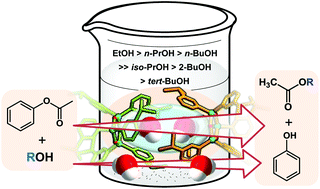Enantiomeric two-fold interpenetrated 3D zinc(ii) coordination networks as a catalytic platform: significant difference between water within the cage and trace water in transesterification†
Abstract
Self-assembly of Zn(ClO4)2 with 1,1,2,2-tetramethyl-1,2-di(pyridin-3-yl)disilane (L) as a bidentate N-donor gives rise to 3D coordination networks, [Zn(μ-OH)(L)]3(ClO4)3·5H2O (1·5H2O), of unique, 103-a srs net topology. An important feature is that two enantiomeric 3D frameworks, 41- and 43-[Zn(μ-OH)(L)]3(ClO4)3·5H2O, are interpenetrated to form a racemic two-fold 3D network with cages occupied by two water molecules. Another structural characteristic is a C3-symmetric planar Zn3(μ-OH)3 6-membered ring with tetrahedral Zn(II) ions. The steric hindrance of substrates and trace water effects on transesterification catalysis using the network have been scrutinized. The coordination network acts as a remarkable heterogeneous transesterification catalytic system that shows both the significant steric effects of substrate alcohols and momentous water effects. The substrate activity is in the order ethanol > n-propanol > n-butanol > iso-propanol > 2-butanol > tert-butanol. For the reaction system, solvate water molecules within the cages of the interpenetrated 3D frameworks do not decrease the transesterification activity, whereas the trace water molecules in the substrate alcohols act as obvious obstacles to the reaction.



 Please wait while we load your content...
Please wait while we load your content...